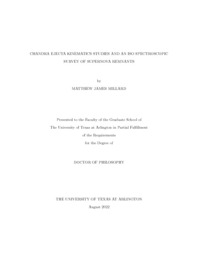
ATTENTION: The works hosted here are being migrated to a new repository that will consolidate resources, improve discoverability, and better show UTA's research impact on the global community. We will update authors as the migration progresses. Please see MavMatrix for more information.
Show simple item record
| dc.contributor.advisor | Park, Sangwook | |
| dc.creator | Millard, Matthew James | |
| dc.date.accessioned | 2022-09-15T13:38:06Z | |
| dc.date.available | 2022-09-15T13:38:06Z | |
| dc.date.created | 2022-08 | |
| dc.date.issued | 2022-08-15 | |
| dc.date.submitted | August 2022 | |
| dc.identifier.uri | http://hdl.handle.net/10106/30961 | |
| dc.description.abstract | The structure of metal-rich ejecta created from a supernova (SN) reveals vital information about the explosion of the progenitor star and the dynamical evolution of the supernova remnant (SNR). This research focuses on the ejecta kinematics of SNRs in two projects. In the first project, we use High Energy Transmission Grating (HETG) spectroscopy and archival Advanced CCD Imaging Spectrometer (ACIS) imaging from the Chandra X-ray Observatory to study the 3-D ejecta structure of the remnants of the historical Type Ia SNe, SN 1572 (Tycho’s SNR) and SN 1604 (Kepler’s SNR). We use our 150 ks high-resolution Chandra HETG spectroscopic observation of Kepler’s SNR to reveal the 3-D spatial distribution of SN ejecta by measuring the line-of-sight (radial) velocities of clumpy ejecta gas throughout the remnants. We measure the radial velocity of 15 ejecta knots mainly in the northern part of the remnant. We estimate high radial velocity of up to ∼ 8000 km/s for some of these ejecta knots.We also measure proper motions for our sample based on the archival Chandra ACIS data taken in 2000, 2006, and 2014. The fastest moving knots show proper motions of up to ∼ 0.′′2 per year. Our measured radial velocity and proper motions imply space velocities up to ∼ 9000 km/s , thus indicating that some of these ejecta knots are almost freely expanding after ∼ 400 yr since the explosion. Assuming that these high-velocity ejecta knots are traveling ahead of the forward shock of the SNR, we estimate the distance to Kepler’s SNR, d ∼ 4.4–7.5 kpc. We find that the ejecta knots in our sample have an average space velocity of ∼ 4600 km/s (assuming a distance of 6 kpc to Kepler’s SNR). We note that 8 of the 15 ejecta knots from our sample show a statistically significant (at the 90% confidence level) redshifted spectrum, compared to only two with a blueshifted spectrum. This may suggest an asymmetry in the ejecta distribution in Kepler’s SNR along the line of sight.
In Tycho’s SNR, we use our 450 ks Chandra HETGS observation to study the ejecta kinematics. We find radial velocities of up ∼ 5,500 km/s in our sample of 59 ejecta knots scattered about the face of the SNR. We also measure the proper motions for our sample based on the archival Chandra ACIS data taken from 2003, 2009, and 2015. We estimate proper motions up to 0.′′35 per year , and total space velocities of up to 6000 km/s (assuming a distance of 3.5 kpc to Tycho’s SNR). We find that ejecta in the southeast quadrant generally expand faster than the rest of the SNR. A 3–D construction shows an apparent asymmetry in the spatial distribution of ejecta clumps with more blueshifted knots located towards the north and more redshifted knots in the south. We find that the inferred positions of the ejecta knots suggest that the reverse shock may reach further into the interior than previously estimated.
In the second project, we study the far-infrared (FIR) spectra of SNRs with a particular focus on searching for high-velocity IR-emitting ejecta (by detecting strong emission line broadening) that may be coincident with emission from newly formed dust in core-collapse (CC) SNRs. Our goal is to help reveal whether CC–SNe could be the main producer of interstellar dust. We present FIR spectroscopy of SNRs based on the archival data of the Infrared Space Observatory taken with the Long Wavelength Spectrometer (LWS). Our sample includes previously unpublished profiles of line and continuum spectra for 20 SNRs in the Galaxy and Magellanic Clouds. In several SNRs including G21.5–0.9, G29.7–0.3, the Crab Nebula, and G320.4–1.2, we find evidence for broad [O I ], [O III ], [N II ], and [C II ] lines. We measure velocity dispersions up to a few 1000 km/s , indicating that they are associated with high-velocity SN ejecta. For G320.4–1.2, we apply a blackbody model fit to the LWS continuum, taking into account the SNR and background emission. Based on this model, we estimate 0.1 – 0.2 M⊙ of interstellar dust formation in this SNR. | |
| dc.format.mimetype | application/pdf | |
| dc.language.iso | en_US | |
| dc.subject | Astronomy | |
| dc.subject | Astrophysics | |
| dc.subject | Supernova remnants | |
| dc.subject | X-rays | |
| dc.subject | Infrared | |
| dc.subject | Radial velocity | |
| dc.subject | Proper motion | |
| dc.subject | Interstellar medium | |
| dc.title | CHANDRA EJECTA KINEMATICS STUDIES AND AN ISO SPECTROSCOPIC SURVEY OF SUPERNOVA REMNANTS | |
| dc.type | Thesis | |
| dc.degree.department | Physics | |
| dc.degree.name | Doctor of Philosophy in Physics and Applied Physics | |
| dc.date.updated | 2022-09-15T13:38:06Z | |
| thesis.degree.department | Physics | |
| thesis.degree.grantor | The University of Texas at Arlington | |
| thesis.degree.level | Doctoral | |
| thesis.degree.name | Doctor of Philosophy in Physics and Applied Physics | |
| dc.type.material | text | |
| dc.creator.orcid | 0000-0001-7106-8502 | |
Files in this item
- Name:
- MILLARD-DISSERTATION-2022.pdf
- Size:
- 20.28Mb
- Format:
- PDF
This item appears in the following Collection(s)
Show simple item record


